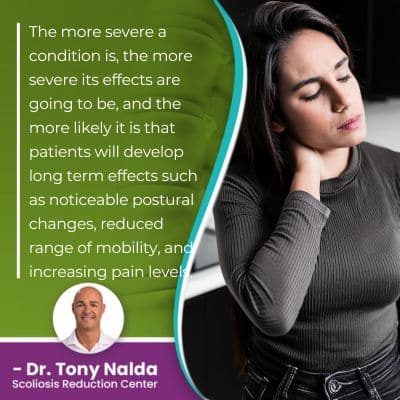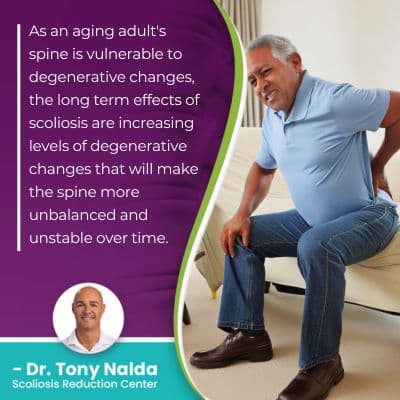What Are The Long Term Effects Of Scoliosis? [Find Out Here]
![. What Are The Long Term Effects Of Scoliosis? [Find Out Here]](https://drtonynalda.com/wp-content/uploads/2024/06/261.-What-Are-The-Long-Term-Effects-Of-Scoliosis-Find-Out-Here.jpg)
As a progressive condition whose nature is to get worse over time, the longer scoliosis is left untreated, or not treated proactively, the more likely it is to have noticeable long term complications and effects. Scoliosis progression means conditions are becoming more severe, as are the condition's effects, and the more progression there is, the more complex scoliosis is to treat.
The long term complications of scoliosis will be case specific based on the type of scoliosis, severity, and the chosen treatment approach. The best way to minimize the potential long term effects of scoliosis is through addressing conditions with a proactive conservative treatment plan.
There are different severity levels and types of scoliosis that shape a patient's life with their condition, including potential long term effects.
Table of Contents
No Two Cases of Scoliosis Are the Same
Scoliosis is most often diagnosed in children, but it also affects adults.
As scoliosis involves the development of an unnatural spinal curve that also rotates, the size of the unnatural spinal curve determines condition severity that can range from mild scoliosis to moderate scoliosis, severe and very severe scoliosis.
As part of diagnosing scoliosis involves further classifying conditions based on key patient/condition variables, and these variables shape a patient's condition, let's explore what some classification points mean for potential condition effects, both short and long term, such as patient age, condition type, and severity.
Patient Age and Scoliosis Effects
As mentioned, scoliosis affects all ages, but the most prevalent age group diagnosed are adolescents between the ages of 10 and 18 as adolescent idiopathic scoliosis (AIS).
Patient age shapes condition effects in two main areas: progression and pain.
Most cases of scoliosis are idiopathic (cause unknown), but we do know what triggers scoliosis to get worse: growth.
So patients who have not yet reached skeletal maturity are the most at risk for progression, and adolescents even more so because of the rapid and unpredictable growth spurts of puberty.
So patient age helps predict a patient's rate of potential progression, and this is important in the context of condition effects because the more scoliosis progresses, the more noticeable its effects tend to be.
Patient age also shapes how painful a person's scoliosis is likely to be because scoliosis doesn't become a compressive condition until skeletal maturity has been reached, and that means that once there is no more growth left for the spine, it becomes vulnerable to the compressive force of the unnatural spinal curve; it's compression of the spine and its surrounding muscles and nerves that causes the majority of condition-related pain.
The constant lengthening motion of growth counteracts the condition's compressive nature, but once skeletal maturity is reached, this is when muscle pain, back pain, and pain that radiates into the extremities due to nerve compression become potential effects.
Condition Type and Scoliosis Effects
The majority of cases of scoliosis are classified as idiopathic scoliosis which is not clearly associated with a single-known cause, and this accounts for approximately 80 percent of known cases, and cases of idiopathic scoliosis are considered typical.
The remaining 20 percent of known cases are associated with known causes: neuromuscular scoliosis, degenerative scoliosis, and congenital scoliosis.
Scoliosis types with known causes are considered atypical so they tend to be more severe, have more noticeable effects, and unique treatment needs, and as these types are atypical and tend to be more severe, their potential long term effects can be more noticeable, particularly if left untreated.
Neuromuscular Scoliosis
For example, in cases of neuromuscular scoliosis, the scoliosis develops as a secondary complication of a larger neuromuscular condition such as spina bifida, muscular dystrophy, and cerebral palsy that causes a disconnect between the brain, the spine, and the muscles and/or connective tissues that support the spine.
The long term effects of neuromuscular scoliosis, particularly if left untreated, can mean becoming nonambulatory (wheelchair bound and unable to walk on their own).
Condition Severity
 The more severe a condition is, the more severe its effects are going to be, and the more likely it is that patients will develop long term effects such as noticeable postural changes, reduced range of mobility, and increasing pain levels.
The more severe a condition is, the more severe its effects are going to be, and the more likely it is that patients will develop long term effects such as noticeable postural changes, reduced range of mobility, and increasing pain levels.
So the long term complications of idiopathic scoliosis are generally not as noticeable as those associated with atypical condition types like neuromuscular scoliosis; typical types of scoliosis can be highly treatable, and a large part of treatment is minimizing the condition's potential long-term effects and the need for more invasive surgical treatment in the future.
As scoliosis ranges widely in severity from mild scoliosis to moderate and severe to very severe scoliosis, the more severe a condition is, the more noticeable its effects are going to be, and the more progression there is likely to be.
Long-Term Effects of Idiopathic Scoliosis
The long term effects of idiopathic scoliosis will vary based on severity and treatment, and when it comes to typical cases of idiopathic scoliosis, the long term effects if left untreated are caused by progression.
As a progressive condition, scoliosis has it in its nature to get worse over time, and this means as it's becoming more severe, its effects are becoming more noticeable.
In children, the long-term effects of progression include increasing postural changes that are caused by how the condition disrupts the body's overall symmetry, and this can include:
- Uneven shoulders
- Uneven shoulder blades
- Development of a rib cage arch
- An uneven waist
- Arms and legs that hang at different lengths
- Ill-fitting clothing because of the body's increasing asymmetry
In addition to the way scoliosis affects posture, it also causes changes to balance, coordination, and gait, and the longer scoliosis is left untreated, or not treated proactively, the more pronounced these changes become.
The long term effects of idiopathic scoliosis can include complications, particularly if left untreated and significant progression occurs: breathing difficulties, headaches/migraines, sleep problems, and pain.
If scoliosis is left untreated in a child, the long-term effects will include progression into skeletal maturity, which is when the condition becomes compressive and painful as it's becoming more severe.
Let's now take a look at the potential long term effects of adult scoliosis, and adult scoliosis that's left untreated.
Long-Term Effects of Adult Scoliosis
The most common type of scoliosis to affect adults is idiopathic scoliosis, and in these cases, the scoliosis developed during adolescence, but was neither diagnosed nor treated so it progressed with time and maturity into adulthood; this is a common scenario as many cases of adolescent idiopathic scoliosis are mild and difficult to detect, but when conditions become painful, they are more noticeable.
It's muscle pain, back pain, and pain that radiates into the extremities that brings the majority of adults in to see me for a diagnosis and treatment.
So the long term effects of adolescent idiopathic scoliosis left untreated include the condition progressing into adulthood and becoming compressive and painful.
The second most common type to affect adults is degenerative scoliosis, diagnosed in older adults once natural age-related spinal degeneration comes into play.
 As an aging adult's spine is vulnerable to degenerative changes, the long term effects of scoliosis are increasing levels of degenerative changes that will make the spine more unbalanced and unstable over time.
As an aging adult's spine is vulnerable to degenerative changes, the long term effects of scoliosis are increasing levels of degenerative changes that will make the spine more unbalanced and unstable over time.
The more spinal degeneration there is, the more difficult it is for the spine to maintain its natural curves and alignment, and a spine that's unstable and unbalanced is going to be painful.
A significant long-term effect of leaving scoliosis untreated is the increasing likelihood of needing invasive surgical treatment in the future, and that is something I proactively work towards preventing.
Conclusion
Here at the Scoliosis Reduction Center, scoliosis can be highly treatable, particularly when early detection and intervention are achieved.
There are no treatment guarantees, but when scoliosis is diagnosed early in its progressive line and is met with a proactive conservative scoliosis treatment approach, there are fewer limits to what can be achieved, and this is the best way to minimize the condition's effects, both short and long term.
So long term effects of scoliosis, if treated proactively, can be minimized, and with a curvature reduction on a structural level and increasing core strength so the spine is supported and stabilized by strong surrounding muscles, the long term effects of scoliosis can be minimal.
There are a number of celebrities and professional athletes who, despite being diagnosed with scoliosis, have thrived in their goals, careers, and sports.
So the long term effects of scoliosis also include the effects of scoliosis treatment, and conservative treatment is a natural and noninvasive treatment approach that works by preserving as much of the spine's natural strength and function as possible.
Scoliosis that's left untreated and becomes severe, or is diagnosed as severe, can be recommended for spinal fusion surgery: traditional scoliosis treatment.
While surgical treatment can straighten a bent spine, it can cost the spine in terms of its overall strength and function, so spinal surgery addressing scoliosis can have long-term effects involving a spine that's weaker and more vulnerable to injury, and one that's not as flexible as it was pre-surgery.
Dr. Tony Nalda
DOCTOR OF CHIROPRACTIC
After receiving an undergraduate degree in psychology and his Doctorate of Chiropractic from Life University, Dr. Nalda settled in Celebration, Florida and proceeded to build one of Central Florida’s most successful chiropractic clinics.
His experience with patients suffering from scoliosis, and the confusion and frustration they faced, led him to seek a specialty in scoliosis care. In 2006 he completed his Intensive Care Certification from CLEAR Institute, a leading scoliosis educational and certification center.
About Dr. Tony Nalda
 Ready to explore scoliosis treatment? Contact Us Now
Ready to explore scoliosis treatment? Contact Us Now





